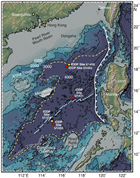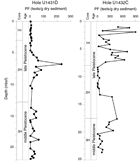Li, C.-F., Lin, J., Kulhanek, D.K., and the Expedition 349 Scientists
Proceedings of the International Ocean Discovery Program Volume 349
publications.iodp.org
https://doi.org/10.14379/iodp.proc.349.204.2018
Data report: middle to late Pleistocene planktonic foraminifer abundances from IODP Holes U1431D, U1432C, and U1433A1
Renata Hanae Nagai2 and Amanda Gerotto2
MS 349-204: Received 1 May 2017 · Accepted 23 October 2017 · Published 9 January 2018
Abstract
The primary goal of this study is to assess the potential of International Ocean Discovery Program Expedition 349 Sites U1431, U1432, and U1433 for middle and late Pleistocene paleoceanographic reconstructions. For this, we recorded planktonic foraminifer abundances (tests/g of dry sediment) from the uppermost sections of Holes U1431D, U1432C, and U1433A. Our data suggest that Hole U1432C presents the highest potential for planktonic foraminifer–based paleoceanographic reconstructions. Planktonic foraminifer abundance fluctuations in sediments from Hole U1431D suggest that this hole is a good candidate to further investigate water-chemistry changes in paleoenvironmental reconstructions since the middle Pleistocene. Meanwhile, the absence planktonic foraminifers precludes the use of this proxy in reconstructions from Hole U1433A.
Introduction
During International Ocean Discovery Program (IODP) Expedition 349, five sites were drilled in the deep basin of the South China Sea (SCS) with the main objective to test hypotheses for timing and opening mechanisms of this marginal basin. Three of these sites (U1431–U1433) retrieved sediment from the northern East, central East, and Southwest Subbasins of the SCS following a north–south transect. Shipboard dating of microfossils indicated that the uppermost sediments recovered from these sites comprise the middle and upper Pleistocene. The location of these sites makes them of particular interest to examine paleoceanographic and sedimentary responses to regional climatic processes.
Planktonic foraminifers are widely used in paleoceanographic reconstructions because their abundance and biodiversity are controlled by surface hydrographic conditions (Jonkers and Kučera, 2015). Planktonic foraminifer test production and flux to the seafloor are mainly controlled by surface-water primary productivity (Jonkers and Kučea, 2015; Salmon et al., 2015). The production, transportation, deposition, and dissolution of carbonate forms a significant part of the global carbon cycle (Wang et al., 2016). In deep ocean basins, carbonate ion concentration (CO3–2) saturation controls carbonate preservation and sedimentary accumulation. The SCS has a deeper lysocline and carbonate compensation depth (CCD) (at ~3000 and 3500 meters below seafloor [mbsf], respectively) than the Western Pacific (Li et al., 2008). Thus, deep-sea sediments deposited in this marginal basin are potential archives for paleoceanographic studies.
Here we present planktonic foraminifer abundances from the middle and upper Pleistocene of Holes U1431D, U1432C, and U1433A. The primary objective of this study is to present the overall abundances of planktonic foraminifers and to provide a first assessment of the potential of these sites for middle and late Pleistocene planktonic foraminifer–based paleoceanographic reconstructions.
Geological setting
The SCS is a large marginal sea in the Western Pacific with a deep central basin (2000–4700 meters below sea level) divided into the Northwestern, East, and Southwest Subbasins (see the Expedition 349 summary chapter [Li et al., 2015]). The East and Southwest Subbasins present contrasts regarding magnetism and water depths, with slightly deeper water in the Southwest Subbasin. The marginal basin sediments are mostly of terrigenous origin, deposited during the Oligocene (~32 Ma), with high sedimentation rates in relation to the global average (~6.22 cm/ky) (Wang and Li, 2009).
We investigated the uppermost sediments retrieved from Holes U1431D, U1432C, and U1433A for foraminifer content. Hole U1431D (15°22′N, 117°00′E; 4240 m water depth), Hole U1432C (18°21.0831′N, 116°23.4504′E; 3829 m water depth), and Hole U1433A (12°55.1380′N, 115°2.8345′E; 4379 m water depth) were retrieved from the SCS central East, northern East, and Southwest Subbasins, respectively (Figure F1), during Expedition 349 onboard the R/V JOIDES Resolution (see the Expedition 349 summary chapter [Li et al., 2015]). The uppermost sediments of Hole U1431D (0–21.46 mbsf) are composed of dark greenish gray clay and silty clay with minor clayey silt, with variable amounts of nannofossil ooze and volcanic ash. The uppermost Hole U1432C sediments (0–24.23 mbsf) are composed of dark greenish gray clay and clay with silt. Hole U1433A (0–244.15 mbsf) sediments are composed of dark greenish gray clay with rare interbeds of thin and very thin (<5 mm) clayey silt. In the upper parts of the hole, dark brownish clay layers intercalate with minor light greenish gray clay with nannofossils and nannofossil ooze layers.
Based on shipboard biostratigraphy analysis, the uppermost sediments of Holes U1431D and U1432C encompass the middle to late Pleistocene, and Hole U1433A encompasses the late Pleistocene. Sedimentation rates based on biostratigraphy and magnetostratigraphy are ~5, 12, and 20 cm/ky for Holes U1431D, U1432C, and U1433A, respectively (see the Expedition 349 summary chapter [Li et al., 2015]).
Material and methods
For this study, ~10 cm3 samples (N = 132) were collected at a sampling resolution of 20 cm over the uppermost sections of Holes U1431D, U1432C, and U1433A. Samples were freeze-dried and are archived in the Paleoceanography and Paleoclimatology Laboratory (LabPaleo2) at the Center for Marine Studies (Federal University of Paraná-UFPR, Pontal do Paraná, Brazil). Samples from Holes U1431D (N = 44), U1432C (N = 43), and U1433A (N = 22) were selected for quantitative planktonic foraminiferal analysis. Each sample was weighed and shaken with distilled water for ~2 h for sediment disaggregation. Samples were then washed with water through a 63 µm mesh sieve and oven-dried at 40°C. To estimate planktonic foraminifer total abundance (tests/g of dry sediment), at least 300 specimens from the >150 µm size fraction were picked under a stereomicroscope and stored on slides.
Results
Planktonic foraminifer abundances for Holes U1431D, U1432C, and U1433A are shown in Table T1 and illustrated in Figure F2. Hole U1432C, the site with the shallowest water depth, yields the highest planktonic foraminifer abundances, varying from 1 to 904 tests/g of dry sediment. Lower planktonic foraminifer abundances are observed in Hole U1431D, with abundances ranging from 0 to 251 tests/g of dry sediment. Hole U1433A samples, from the deepest of the three sites, are barren of planktonic foraminifers in the >150 µm size fraction.
T1. Planktonic foraminifer abundances. Download table in CSV format.
In general, Hole U1431D samples have low planktonic foraminifer abundances. Between Sample 349-U1431D-3H-7, 40–42 cm, and 2H-5, 100–102 cm (21.81–10.20 mbsf), samples contain 0–61 tests/g of dry sediment. The interval from Samples 2H-4, 119–121 cm, to 2H-2, 100–102 cm (8.89–5.70 mbsf), has the highest planktonic foraminifer abundances (between 23 and 231 tests/g of dry sediment). The uppermost samples from Hole U1431D (Samples 2H-1, 140–142 cm, to 1H-1, 0–2 cm [4.60–0 mbsf]), contain the lowest planktonic foraminifer abundances, between 0 and 10 tests/g of dry sediment. Overall, planktonic foraminifers in Hole U1431D are moderately to well preserved.
Planktonic foraminifers in Hole U1432C are well preserved. Higher planktonic foraminifer abundances (between 120 and 904 tests/g of dry sediment) are observed between Samples 349-U1432C-1H-2, 42–44 cm, and 1H-1, 101–103 cm (1.98–1.02 mbsf); 1H-6, 22–24 cm, and 1H-4, 76–78 cm (7.33–5.08 mbsf); and 3H-2, 77–79 cm, and 2H-5, 21–23 cm (19.69–13.64 mbsf). These intervals are intercalated with intervals (Samples 3H-5, 21–23 cm, to 3H-2, 139–141 cm [23.63–20.31 mbsf]; 1H-4, 21–23 cm, to 1H-2, 101–103 cm [4.54–2.51 mbsf]; and 2H-4, 81–83 cm, to 2H-1, 39–41 cm [13.23–8.31 mbsf]) of lower abundances.
Hole U1433A samples are barren in the >150 µm planktonic foraminifer fraction except for Samples 349-U1433A-2H-5, 40–42 cm (15.35 mbsf), 2H-4, 100–102 cm (14.45 mbsf), 2H-3, 100–102 cm (12.95 mbsf), 1H-4, 107–109 cm (5.57 mbsf), and 1H-3, 22–24 cm (3.22 mbsf), which contain abundant planktonic and benthic foraminifers associated with the turbidite deposits of lithostratigraphic Unit I (see the Expedition 349 summary chapter [Li et al., 2015]).
In general, tropical and subtropical species that are commonly found in the modern SCS compose middle to late Pleistocene planktonic foraminifer assemblages deposited in the SCS deep-basin sediments. The most abundant planktonic foraminifer species observed in Holes U1431D and U1432C are Globigerina falconensis, Globoturborotalita rubescens, Globigerina bulloides, Globigerinella calida, Globigerinoides ruber (white), Globigerinoides sacculifera, Globorotalia inflata, Globorotalia menardii, Neogloboquadrina pachyderma (left and right coiling), Neogloboquadrina dutertrei, Neogloboquadrina incompta, and Pulleniatina obliquiloculata. Hole U1431D assemblages are dominated by G. ruber (white), G. sacculifera, N. dutertrei, N. pachyderma (right coiling), and N. incompta, whereas G. inflata, P. obliquiloculata, N. dutertrei, G. ruber (white), and G. sacculifera dominate the Hole U1432C assemblage.
Planktonic foraminifer abundance changes and variations in test preservation observed between Holes U1431D and U1432C highlight the need for future studies regarding changes in SCS deep-seawater chemistry. On the other hand, the absence of planktonic foraminifers in the mid-upper Pleistocene sequences of Hole U1433A preclude using this proxy for paleoceanographic studies due to poor carbonate preservation.
Acknowledgments
This research is based on samples and data collected by the International Ocean Discovery Program (IODP). The science party members, crew, and technicians aboard the R/V JOIDES Resolution are acknowledged for their work during IODP Expedition 349. Funding was provided by IODP/CAPES-Brasil (Edital 38/2014, Proc. 8887.091705/2014-01). The authors would also like to acknowledge CAPES for scholarships received by Renata Hanae Nagai (BEX 14531/13-5) and Amanda Gerotto (Demanda Social) and the undergraduate students from Centro de Estudos do Mar at UFPR for sample washing. The authors would also like to acknowledge an anonymous reviewer and Dr. Denise Kulhanek for their valuable comments and suggestions.
References
Jonkers, L., and Kučera, M., 2015. Global analysis of seasonality in the shell flux of extant planktonic foraminifera. Biogeosciences, 12:2207–2226. https://doi.org/10.5194/bgd-12-1327-2015
Li, C.-F., Lin, J., Kulhanek, D.K., Williams, T., Bao, R., Briais, A., Brown, E.A., Chen, Y., Clift, P.D., Colwell, F.S., Dadd, K.A., Ding, W., Hernández-Almeida, I., Huang, X.-L., Hyun, S., Jiang, T., Koppers, A.A.P., Li, Q., Liu, C., Liu, Q., Liu, Z., Nagai, R.H., Peleo-Alampay, A., Su, X., Sun, Z., Tejada, M.L.G., Trinh, H.S., Yeh, Y.-C., Zhang, C., Zhang, F., Zhang, G.-L., and Zhao, X., 2015. Expedition 349 summary. In Li, C.-F., Lin, J., Kulhanek, D.K., and the Expedition 349 Scientists, South China Sea Tectonics. Proceedings of the International Ocean Discovery Program, 349: College Station, TX (International Ocean Discovery Program). https://doi.org/10.14379/iodp.proc.349.101.2015
Li, Q., Wang, P., Zhao, Q., Tian, J., Cheng, X., Jian, Z., Zhong, G., and Chen, M., 2008. Paleoceanography of the mid-Pleistocene South China Sea. Quaternary Science Reviews, 27(11–12):1217–1233. https://doi.org/10.1016/j.quascirev.2008.02.007
Salmon, K.H., Anand, P., Sexton, P.F., and Conte, M., 2015. Upper ocean mixing controls the seasonality of planktonic foraminifer fluxes and associated strength of the carbonate pump in the oligotrophic North Atlantic. Biogeosciences, 12(1):223–235. https://doi.org/10.5194/bg-12-223-2015
Wang, N., Huang, B.-Q., and Li, H., 2016. Deep-water carbonate dissolution in the northern South China Sea during marine isotope Stage 3. Journal of Palaeogeography, 5(1):100–107. https://doi.org/10.1016/j.jop.2015.11.004
Wang, P., and Li, Q. (Eds.), 2009. Developments in Paleoenvironmental Research (Volume 13): The South China Sea: Paleoceanography and Sedimentology: Dordrecht, The Netherlands (Springer). https://doi.org/10.1007/978-1-4020-9745-4
1 Nagai, R.H., and Gerotto, A., 2018. Data report: middle to late Pleistocene planktonic foraminifer abundances from IODP Holes U1431D, U1432C, and U1433A. In Li, C.-F., Lin, J., Kulhanek, D.K., and the Expedition 349 Scientists, South China Sea Tectonics. Proceedings of the International Ocean Discovery Program, 349: College Station, TX (International Ocean Discovery Program). https://doi.org/10.14379/iodp.proc.349.204.2018
2 Centro de Estudos do Mar, Universidade Federal do Paraná, Brazil. Correspondence author: renatanagai@ufpr.br
This work is distributed under the Creative Commons Attribution 4.0 International (CC BY 4.0) license. 

